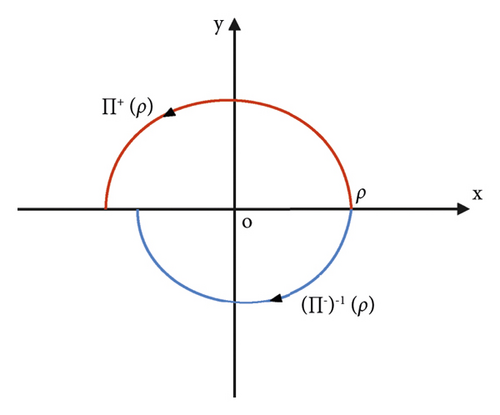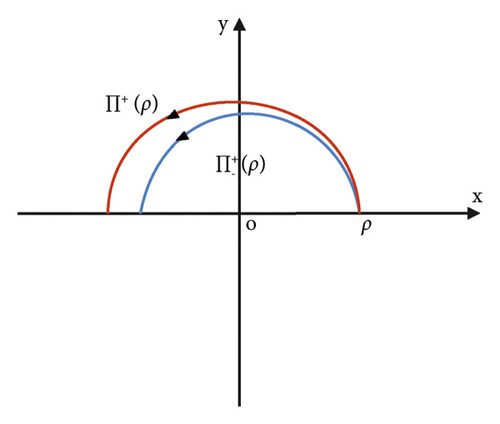Limit Cycles and Local Bifurcation of Critical Periods in a Class of Switching Z2 Equivariant Quartic System
Abstract
In this paper, the limit cycles and local bifurcation of critical periods for a class of switching Z2 equivariant quartic system with two symmetric singularities are investigated. First, through the computation of Lyapunov constants, the conditions of the two singularities to become the centers are determined. Then, we prove that there are at most 18 limit cycles with a distribution pattern of 9-9 around the two symmetric singular points of the system. Numerical simulation is conducted to validate the obtained results. Furthermore, by calculating the period constants, we determine the conditions for the critical point to be a weak center of finite order. Finally, the number of local critical periods that bifurcate from the equilibrium point under the center conditions is discussed. This study presents the first example of a quartic switching smooth system with 18 limit cycles and 4 local critical periods bifurcating from two symmetric singular points.
1. Introduction
In the qualitative theory of differential equations, a crucial focus is on identifying isochronous centers and the bifurcation of critical periods within a period annulus. Similar to smooth systems, this study also aims to analyze whether the orbits near the center of system (1) have the same period. If these orbits share the same period, the origin of the system (1) is classified as an isochronous center. Alternatively, if the orbits near the center do not share the same period, it becomes essential to determine the order of the weak center and the maximum number of local critical periods that bifurcate from a finite order weak center. Chicone and Jacobs [24] introduced the theory of local bifurcation of critical periods and the definition of weak center of k-order for smooth systems. Additional relevant results for smooth systems can be found in [25–27] and references therein. However, limited research has been conducted on the investigation of isochronous centers and the bifurcation of critical periods for piecewise smooth systems. Chen et al. [28] proposed a new method for calculating the periodic constant near the center of a piecewise smooth system and discussed the problem of bifurcation of local critical periods for a switching Z2 equivariant cubic system. It was found that there are at most 5 local critical periods bifurcating from a single singular point. Huang et al. [29] investigated small-amplitude crossing limit cycles and local critical periods for some classes of piecewise smooth Kukles systems of degrees 3 and 4 and acquired new lower bounds for the local cyclicity and the criticality.
The rest of the paper is organized as follows. In the next section, we present preliminary information on the algorithm for calculating the Lyapunov constants and period constants for piecewise smooth systems, which can be easily implemented in computer algebraic software. In Section 3, we determine the necessary and sufficient condition for the equilibrium point to be a center by computing the Lyapunov constants for system (3) at the origin. In Section 4, the bifurcation of limit cycles for system (3) is investigated, demonstrating that there can be at most 18 limit cycles surrounding two symmetric equilibrium points under a suitable perturbation. In Section 5, the corresponding period constants are computed under the obtained center conditions, revealing that the equilibrium point of system (3) is not an isochronous center and that the maximum number of local critical period bifurcations from two symmetric equilibrium points is 4. Finally, conclusions are given in Section 6.
2. Preliminaries
In order to investigate the limit cycles and local bifurcation of critical periods for piecewise smooth systems, this section introduces fundamental concepts and techniques that will be utilized in subsequent sections. The approach outlined in [28, 30] is employed in this study to calculate Lyapunov constants and period constants for piecewise smooth systems, following the procedure described in the following.



Definition 1 (see [28], [29].)The origin of system (3) is a k/2 th-order weak focus if and only if V1 = V2 = ⋯ = Vk = 0, Vk+1 ≠ 0, and the origin is called a rough focus if the order of weak focus is 0, i.e., V1 ≠ 0; the origin is a center if Vk = 0 for all k > 1.
The main issue at hand is how the order k/2 of the weak focus determines the maximum number of limit cycles that bifurcate from a finite order weak focus. In 2015, Chen, Romanovski, and Zhang provided the following result to address this question.
Proposition 2 (see [32].)Assuming that the origin is a weak focus of order k/2 in system (3) associated with the parameter value λ∗, it can be concluded that at most k limit cycles bifurcate from this weak focus at the parameter value λ∗.
To determine if there are perturbations that result in the bifurcation of exactly k limit cycles, one can refer to the following lemma as outlined in reference, Lemma 4 [9].
Lemma 3 (see [9].)If there exists λ∗ = (a1c, a2c, …, akc) such that Vi(λ∗) = 0, i = (1, 2, …, k), Vk+1(λ∗) ≠ 0 and det[∂(V1, V2, …, Vk)/∂(a1, a2, …, ak)] ≠ 0, system (3) just has k limit cycles from the origin (where λ = λ∗).
By means of transformation (x, y, t)⟶(x, −y, −t), the half-periodic functions P−(Π+(ρ)) of system (4) changes into positive half-periodic functions .
If P1 = P2 = ⋯ = Pk = 0, Pk+1 ≠ 0, the origin of system (4) is a k − 1/2 th-order weak center. If k = 0, the origin is a strong center. If Pk = 0 for all k > 1, the origin is an isochronous center.
Similar to smooth systems, a local critical period is a period that corresponds to a critical point of the period function resulting from a bifurcation from a weak center. More precisely, the definition of k local critical periods is as follows.
Definition 4 (see [28].)Suppose that the origin is a weak center corresponding to the parameter λ∗. If there exists a λ ∈ W such that P′(ρ, λ) = 0 has k solutions in every sufficiently small neighborhood W of λ∗, then system (3) has k local critical periods bifurcating from the center.
In what follows, the key issue is how the order (k − 1)/2 of the weak focus decides the maximum number of local critical periods that bifurcate from a finite order weak center. In 2022, Huang, He, and Cai presented the following result to answer this question.
Proposition 5 (see [29].)If the origin is a weak center of order (k − 1)/2 in system (3) associated with the parameter value λ∗, then no more than k local critical periods emerge from this weak center at the parameter value λ∗.
To determine if there exist perturbations such that exactly k local critical periods are created, one can refer to the following lemma as outlined in reference [28, 33].
Lemma 6 (see [28], [33].)If there exists λ∗ = (a1c, a2c, …, akc) such that Pi(λ∗) = 0, i = (1, 2, …, k), Pk+1(λ∗) ≠ 0 and det[∂(P1, P2, …, Pk)/∂(a1, a2, …, ak)] ≠ 0, system (3) just has k critical periods bifurcating from the origin (where λ = λ∗).
In addition, we also want to know whether the origin of switching systems is a center if the first k th-order Lyapunov constants vanish. Some criteria for determining whether the equilibrium point of switching systems is a center are provided in [11].
3. Lyapunov Constants and Center Conditions
In this section, we compute the Lyapunov constants of the corresponding equilibria and find center conditions of system (3) at the origin. First of all, it is easy to check that system (3) always has two singular point O1 = (1, 0) and O2 = (−1, 0). Due to the Z2 symmetry, we choose only O1 to analyze in detail.
Theorem 8. The first ten Lyapunov constants at the origin of system (20) are given by
Case 9. a12 = 0
Case 10. a12 ≠ 0, V60 = 0 (i.e. )
In the above expressions of Vk, we have already set Vk−1 = 0 (k = 2, 3, …, 10).
Next, we discuss the center conditions of system (20). From Theorem 8, we obtain the following results.
Theorem 11. The first ten Lyapunov constants at the origin of system (20) are zero if and only if the following conditions are satisfied:
Proof. From the expressions of the first ten Lyapunov constants given in Theorem 8, the sufficiency of the conditions in Theorem 12 is obvious. Next, we prove that the conditions in Theorem 12 are also necessary.
Letting the second Lyapunov constant V1 = V2 = 0, we have δ = a31 = 0 and
Taking V3 = 0 yields a22 = −1/2(−8b12 − 3b13) and V4 = 8/45(20a12 − 3a13). If V4 = 0, we get a13 = 20a12/3 and . Setting V5 = 0, we obtain and
Then, solving V6 = 0 yields a12 = 0 or V60 = 0. If a12 = 0 , we have V7 = V8 = V9 = V10 = 0. This leads to the conditions a31 = 0, a22 = −4b12, a13 = 0, b13 = 0, a12 = 0. On the other hand, under the condition a12 ≠ 0, taking V60 = 0 (in particular ), we get
Taking V7 = 0, we obtain V70 = 0 (i.e., ) and
Next, we need to judge whether the equations V8 = 0, V9 = 0 and V10 = 0 have common solutions, that is, to discuss whether or not the polynomials F1, F2 and F3 have common zeros. For this purpose, we compute the Grbner basis of the ideal 〈F1, F2, F3〉 and get
This means that the polynomials F1, F2 and F3 have no common zeros. The proof of Theorem 12 is complete.
4. Bifurcation of Limit Cycles
According to the above analysis and Theorem 12, we obtain the following theorem.
Theorem 13. The origin of system (20) is a 9/2 th-order weak focus if and only if the following conditions are satisfied:
According to Lemma 3, the following theorem is concluded.
Theorem 14. Assume that the conditions of Theorem 14 hold, then 9 limit cycles can bifurcate from the equilibrium point of system (20) after a small perturbation. Accordingly, 18 limit cycles can exist in a small neighborhood of two symmetric equilibria (1.0) and (−1, 0) of system (3).
5. Local Bifurcation of Critical Periods
In this section, we investigate the order of a finite weak center and the number of local critical periods when the origin is a center for system (20).
For every Pk that was calculated, we already imposed that P1 = ⋯ = Pk−1 = 0, k = 2, 3. Through analysis, it was found that the equation p3 = 0 has no real root, that is, the equations P1 = 0, P2 = 0, and P3 = 0 have no common zeros. Therefore, the origin of system (20) is not an isochronous center.
According to the above analysis and Lemma 6, we have the following theorem.
Theorem 15. The highest order of the weak center for system (20) at the origin is 2 if the condition (30) holds, i.e., at most 2 critical periods are generated from the center of system (20). Accordingly, at most 4 critical periods can bifurcate from two symmetric equilibria (1, 0) and (−1, 0) of system (3).
6. Conclusion and Discussion
Based on an exact symbolic computation of Lyapunov constants and period constants, we have studied the center problem and determined the maximum number of limit cycles and local critical periods for a class of switching Z2 equivariant quartic system. Our findings reveal that at most 18 limit cycles and 4 local critical periods can bifurcate from two symmetric singular points. Up to our knowledge, the result of 18 limit cycles and 4 local critical periods are two new lower bounds on the maximum number of small-amplitude limit cycles and local critical periods for quartic switching smooth systems. The complexity of calculating Lyapunov constants and period constants in piecewise smooth systems increases with the degree of system (1). Compared to smooth systems, it is more challenging to improving the maximum number of limit cycles and local critical periods in these systems. Therefore, developing a more efficient method for calculating Lyapunov constants and period constants in piecewise smooth systems remains a challenging task.
Conflicts of Interest
The authors declare that they have no conflicts of interest.
Acknowledgments
This work was supported by the National Natural Science Foundation of China (12061016) and the Basic Ability Enhancement Program for Young and Middle-Aged Teachers of Guangxi (2022KY0198 and 2022KY0254).
Appendix
Open Research
Data Availability
A code snippet is provided in the Appendix.




